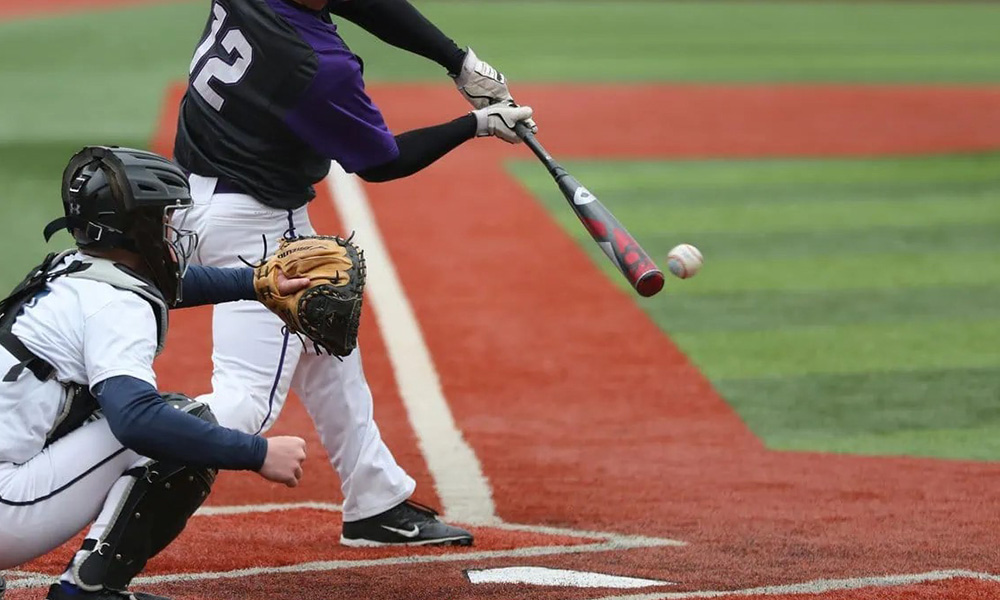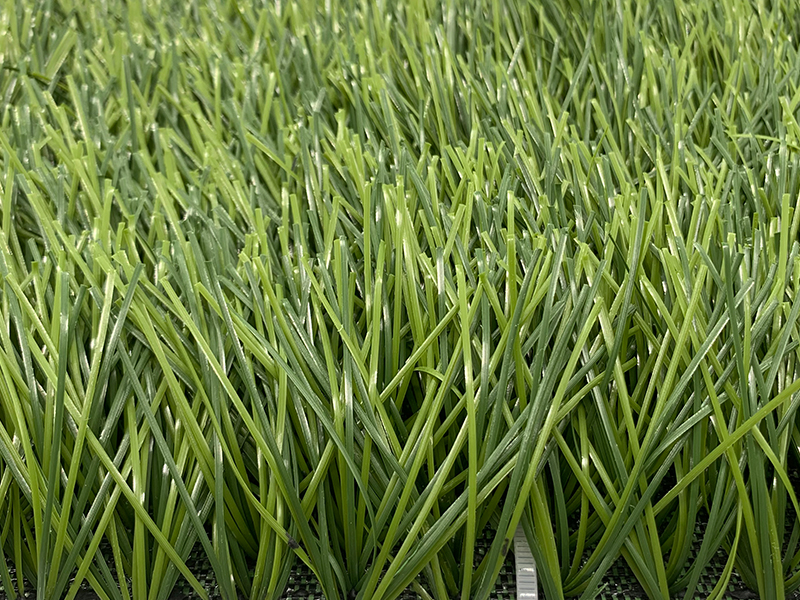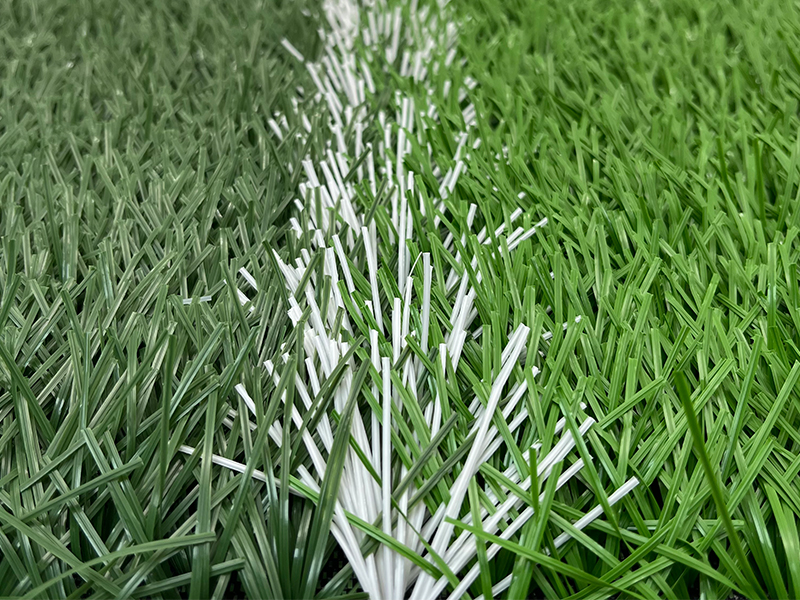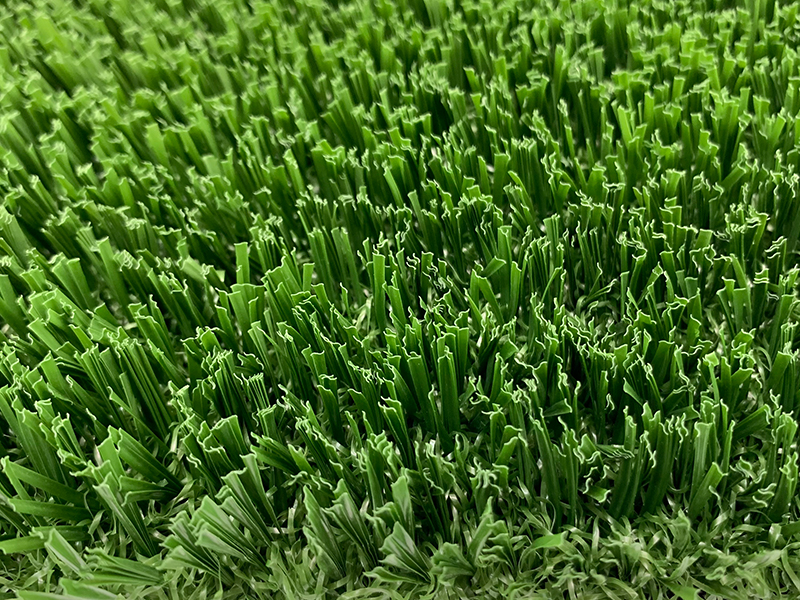Standard football turf specifications selection
As one of the most popular sports in the world, football has strict and professional requirements for the construction of competition venues. Artificial turf has become the preferred material for modern football field construction due to its excellent durability, all-weather applicability and easy maintenance. This article will comprehensively introduce the artificial turf specifications, filling systems, field layout and safety performance of standard football fields to help you build a high-performance football field that meets international standards.
I. Field size and area range
The size of a standard 11-a-side football field should meet the FIFA certification standards:
- Total field area: about 6400㎡~8250㎡
- Length (long side): 100 meters to 110 meters
- Width (short side): 64 meters to 75 meters
Auxiliary area dimensions:
- Corner circle: An arc-shaped area with a radius of 1 meter centered on the intersection of the goal line and the touchline.
- Center circle: A circular area with a radius of 9.15 meters centered on the center of the field.
- Goal area: A rectangular area extending 5.5 meters into the field from both ends of the goal line, with a width of 18.32 meters.
II. Core parameters of artificial turf
| Type | Standard range | function |
| Grass Height | 50mm~65mm |
|
| Grass Density | 9500~10500 needles/㎡ | A density of ≥10,000 needles/m² is suitable for high-frequency use scenarios and extends service life. |
| DETX | ≥6000 | This reflects the thickness and toughness of the grass fibers; the higher the value, the more resistant to friction and tension. For competition-grade fields, a value of ≥8000 is recommended. |
| Fiber Type | Monofilament/Curved Filament/ Mixed grass fibers | Monofilaments have a feel similar to natural grass and are durable and abrasion-resistant; crisscross filaments are soft, shock-resistant, and less expensive; blended filaments balance performance and safety. |
| UV Resistance | ≥5 levels | Adaptable to high-temperature and sun-exposed environments, preventing lawn fading and aging, and extending its service life. |

III. Professional filling system configuration
Artificial turf football fields need to be equipped with high-quality filling materials to improve sports performance, buffering capacity and drainage effects:
1. Quartz Sand Infill
- Particle size: 0.3~1.5mm (1.2-1.5mm is recommended for rainy areas to improve drainage efficiency)
- Silicon content: ≥90%, ensuring chemical stability and environmental friendliness.
- Recommended filler volume: 20~30kg/㎡ (28-30kg/㎡ for competition-level, 22-25kg/㎡ for campus-level, and 20-22kg/㎡ for commercial-level)
- Core function: Enhances lawn root stability, provides basic support, and prevents grass from lodging.
2. Rubber Granule Infill
- Particle size: 1~3mm
- Recommended filler volume: 5~8kg/㎡ (7-8kg/㎡ for competition-grade, 5-6kg/㎡ for campus-grade)
- Material selection: Environmentally friendly EPDM rubber granules (free of heavy metals and odorless, suitable for school campuses) / Ordinary rubber granules (high cost-performance ratio, suitable for commercial venues)
- Core functions: Enhances the elasticity and rebound performance of the playing surface, absorbs the impact of sports activities, and reduces the risk of sprains and falls.
IV. Standard venue functional area design
1. Penalty Area Delineation
- Draw a 16.5-meter vertical line from each end of the goal line into the field, intersecting the goal line perpendicularly.
- The endpoints of the vertical line are connected by a line segment parallel to the goal line to form a rectangular penalty area.
- Penalty spot: Located 11 meters into the field from the center of the goal line, and must be clearly marked.
2. Penalty Arc Settings
- Draw an arc with a radius of 9.15 meters centered on the free-throw line.
- The arc must connect with the outer edge of the free-throw line to regulate the positioning of other players during free throws (they must be at least 9.15 meters away from the free-throw line).
3. Goal Structure & Size Standards
- Goal width: 7.32 meters (distance between the inside of the two posts)
- Goal height: 2.44 meters (distance from the ground to the bottom edge of the crossbar)
- Column and beam specifications: thickness ≤ 12cm, must be symmetrical, and it is recommended to use anti-corrosion steel or high-strength composite materials.
- Installation requirements: Both fixed and movable goals must be securely installed with sufficient base weight to prevent them from tipping over and causing injury.
V. Scenario-Based Selection Guide
Different usage scenarios have significantly different requirements for site specifications. The following are selection options:
| Venue Type | Core Requirements | Recommended Configuration Parameters |
| FIFA Certified Competition-Level | Stable ball speed, qualified impact absorption, wear resistance |
|
| Professional Training-Level | Wear resistance, easy maintenance, cost balance |
|
| Campus Venue (Primary & Secondary Schools) | Safety anti-collision, environmental protection and odorless |
|
| Commercial Rental Venue | Low cost, quick construction, high-frequency use resistance |
|
| Rainy Area Venue | Efficient drainage, anti-waterlogging |
|
| High-Temperature Area Venue | UV resistance, flame retardancy, high-temperature resistance |
|

VI. Safety and environmental standards
The artificial turf provided by Guangzhou UNIGRASS has passed the authoritative inspection of the National Sports Goods Quality Inspection Center and has the following advantages:
Environmentally friendly and non-toxic:
does not contain heavy metals and harmful substances
Flame retardant and non-slip:
meets the safety standards of public sports venues
Strong weather resistance:
can adapt to high temperature, severe cold, rainy and other climates
Easy to maintain:
no need for frequent watering and mowing, greatly reducing operating costs
VII. Professional selection suggestions
To build a football stadium that meets international standards, in addition to selecting high-quality turf, the following core factors must also be considered:
1. Venue Purpose: Clearly define the venue's purpose as competition-level, training-level, campus venue, or commercial venue, and match the corresponding specifications and requirements;
2. Budget Cost: The type of turf (monofilament/curved filament), the material and amount of infill material will directly affect the overall cost. It is necessary to balance performance and cost based on the requirements.
3. Drainage system design: A scientific drainage plan is key to ensuring the long-term stable use of the site and avoiding water accumulation problems;
4. Edge trimming and auxiliary equipment: Complete auxiliary facilities such as lighting, fences, and grandstands are required. At the same time, attention should be paid to the standardization of edge trimming to improve the overall practicality and safety of the venue.
We recommend choosing the experienced supplier UNIGRASS, which provides a one-stop solution from design, material selection, construction to after-sales service, which can greatly improve construction efficiency and ensure that the site quality meets international standards and usage requirements.






